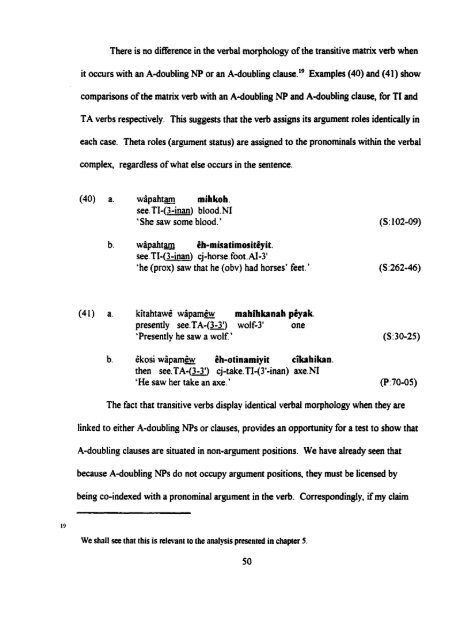Adverbial and Argument-Doubling Clauses in Cree - MSpace
Adverbial and Argument-Doubling Clauses in Cree - MSpace
Adverbial and Argument-Doubling Clauses in Cree - MSpace
Create successful ePaper yourself
Turn your PDF publications into a flip-book with our unique Google optimized e-Paper software.
There is no difference <strong>in</strong> the verbal morphology of the transitive mat& vab when<br />
it occurs with an A-doubl<strong>in</strong>g NP or an A-doubl<strong>in</strong>g clause.lg Examples (40) <strong>and</strong> (41) show<br />
cornparisons of the matrix verb with an A-doubl<strong>in</strong>g NP <strong>and</strong> A-doubl<strong>in</strong>g clause. for TI <strong>and</strong><br />
TA verbs respectively. This suggests that the verb assigns its argument roles identically <strong>in</strong><br />
each case. Theta roles (argument status) are assigned to the pronom<strong>in</strong>als with<strong>in</strong> the verbal<br />
cornplex, regardless of what else occurs <strong>in</strong> the sentence.<br />
(40) a. wâpaht- rnihkoh.<br />
see. TI-(3-<strong>in</strong>) b1ood.M<br />
'She saw some blood. '<br />
b. wâpahtm Eh-misatirnositêyit.<br />
see. TL(3 +an) cj-horse. foot . AI-3'<br />
'he (prox) saw that he (obv) had horses' feet.'<br />
(4 1) a. kîtahtawê wâpamh mahihicanah pêyak.<br />
presently see.TA-(-) wolf-3' one<br />
'Presently he saw a wolf '<br />
b. êkosi wâpamh êh-ot<strong>in</strong>arniyit dkrhikrn.<br />
then see. TAo(3-3') cj-take. TI-(3'4nan) axeM<br />
'He saw her take an axe.' (P: 70-05)<br />
The fact that transitive verbs display identical verbal morphology when they are<br />
l<strong>in</strong>ked to either A-doubl<strong>in</strong>g NPs or clauses, provides an opportunity for a test to show that<br />
A-doubl<strong>in</strong>g clauses are situated <strong>in</strong> nofiargument positions. We have already seen that<br />
because A-doubl<strong>in</strong>g NPs do not occupy argument positions, they must be licensed by<br />
be<strong>in</strong>g CO-<strong>in</strong>dexed with a pronom<strong>in</strong>al argument <strong>in</strong> the verb. Correspond<strong>in</strong>gly, if my daim<br />
- - -<br />
19<br />
We shall see that this is relevant to the analysis presented <strong>in</strong> chaptcr 5.








![an unusual bacterial isolate from in partial fulf]lment for the ... - MSpace](https://img.yumpu.com/21942008/1/190x245/an-unusual-bacterial-isolate-from-in-partial-fulflment-for-the-mspace.jpg?quality=85)




![in partial fulfil]ment of the - MSpace - University of Manitoba](https://img.yumpu.com/21941988/1/190x245/in-partial-fulfilment-of-the-mspace-university-of-manitoba.jpg?quality=85)


